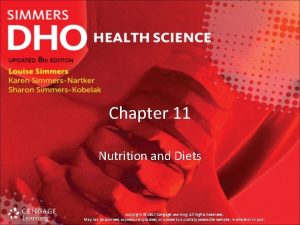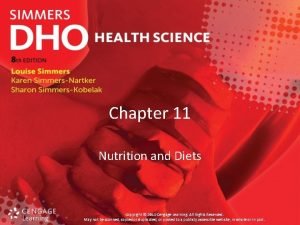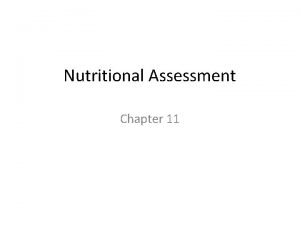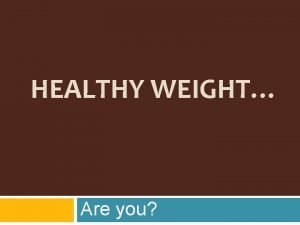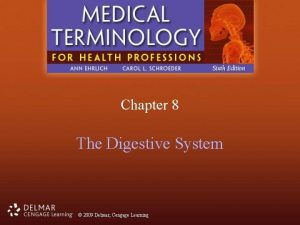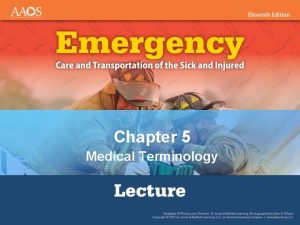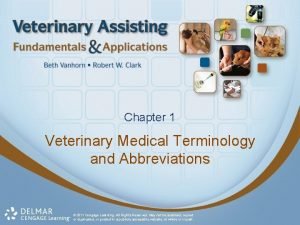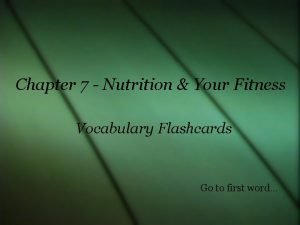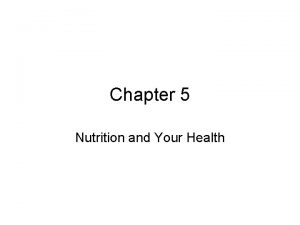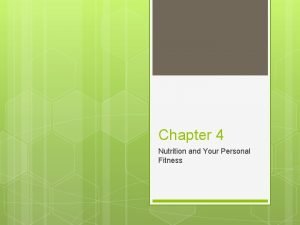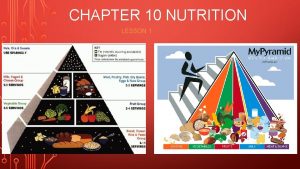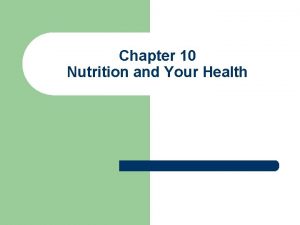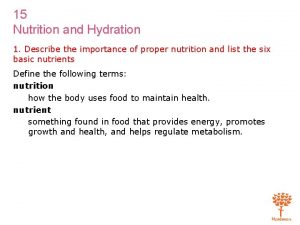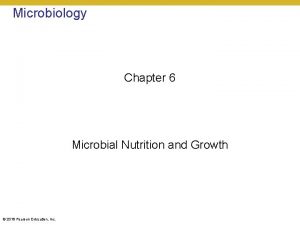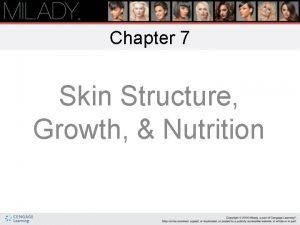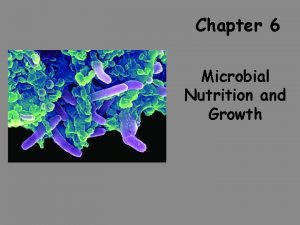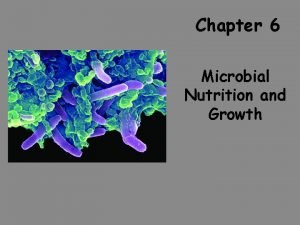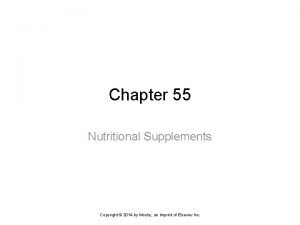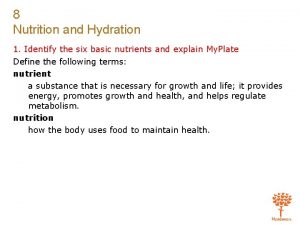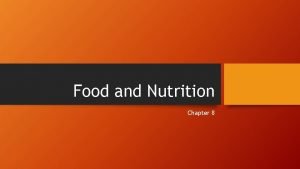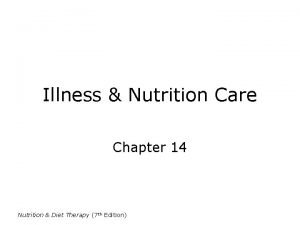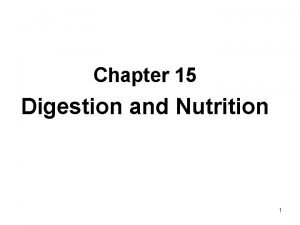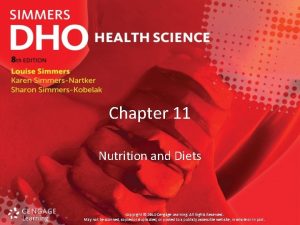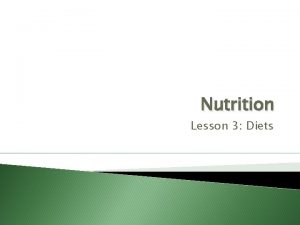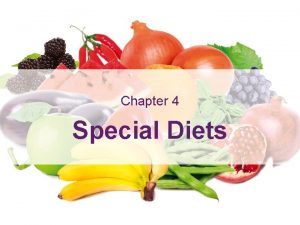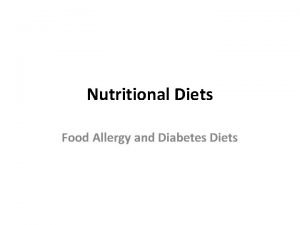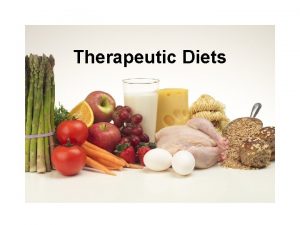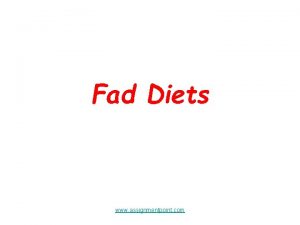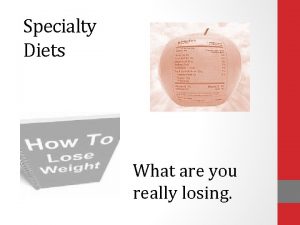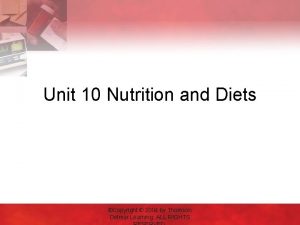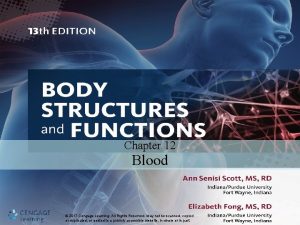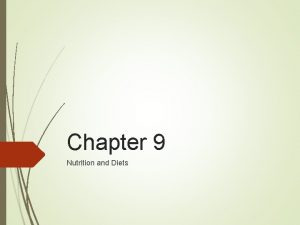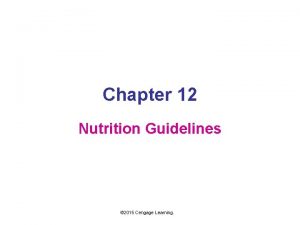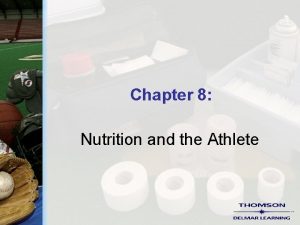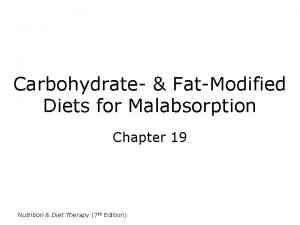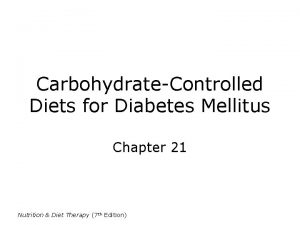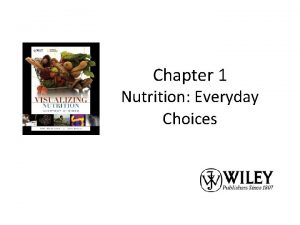Chapter 11 Nutrition and Diets Copyright 2017 Cengage






































- Slides: 38

Chapter 11 Nutrition and Diets Copyright © 2017 Cengage Learning. All Rights Reserved. May not be scanned, copied or duplicated, or posted to a publicly accessible website, in whole or in part.

11: 1 Fundamentals of Nutrition • Most people know there is a fundamental relationship between food and good health • Know what nutrients are needed • Choose proper foods for optimum health • Health care workers should practice and promote good nutrition Copyright © 2017 Cengage Learning. All Rights Reserved. May not be scanned, copied or duplicated, or posted to a publicly accessible website, in whole or in part.

11: 1 Fundamentals of Nutrition • Nutrition – All body processes relating to food • Nutritional status – State or condition of one’s nutrition • Wellness – State of good health and optimal body function Copyright © 2017 Cengage Learning. All Rights Reserved. May not be scanned, copied or duplicated, or posted to a publicly accessible website, in whole or in part.

11: 1 Fundamentals of Nutrition • Good nutrition effects – Healthy appearance – Well-developed body – Good attitude – Proper sleep and bowel habits – High energy level and enthusiasm – Freedom from anxiety Copyright © 2017 Cengage Learning. All Rights Reserved. May not be scanned, copied or duplicated, or posted to a publicly accessible website, in whole or in part.

11: 1 Fundamentals of Nutrition • Good nutrition prevents or delays – Hypertension – Atherosclerosis – Osteoporosis – Diabetes mellitus – Malnutrition (including obesity) Copyright © 2017 Cengage Learning. All Rights Reserved. May not be scanned, copied or duplicated, or posted to a publicly accessible website, in whole or in part.

11: 2 Essential Nutrients • Composed of chemical elements found in food • Used to perform many body functions • As essential nutrients are used by the body, they are replaced by food eaten • Nutrients are divided into six groups (refer to Table 11 -1 in text) Copyright © 2017 Cengage Learning. All Rights Reserved. May not be scanned, copied or duplicated, or posted to a publicly accessible website, in whole or in part.

Carbohydrates • Major source of readily usable human energy • Commonly called starches or sugars • Sources include breads, cereals, pastas, grains, fruits, sugar • Cellulose – Indigestible form of plant carbohydrate, provides bulk in digestive tract Copyright © 2017 Cengage Learning. All Rights Reserved. May not be scanned, copied or duplicated, or posted to a publicly accessible website, in whole or in part.

Lipids (Fats) • Commonly called fats and oils • Organic compounds • Triglycerides, phospholipids, and sterols are most common in food and human body • May be saturated or polyunsaturated • Cholesterol – Sterol in body cells and animal products Copyright © 2017 Cengage Learning. All Rights Reserved. May not be scanned, copied or duplicated, or posted to a publicly accessible website, in whole or in part.

Proteins • Basic components of all body cells • Essential to repairing tissue, regulating body functions, providing energy and heat • 22 amino acids make up proteins – 9 amino acids are complete proteins – 13 amino acids are incomplete proteins Copyright © 2017 Cengage Learning. All Rights Reserved. May not be scanned, copied or duplicated, or posted to a publicly accessible website, in whole or in part.

Vitamins • Organic compounds essential to life – Metabolism, tissue building, regulation of body processes • Antioxidants protect the body from free radicals • May be water-soluble or fat-soluble • Refer to Table 11 -2 in text Copyright © 2017 Cengage Learning. All Rights Reserved. May not be scanned, copied or duplicated, or posted to a publicly accessible website, in whole or in part.

Minerals • Inorganic elements found in body tissues – Regulate body fluids – Assist body functions – Contribute to growth – Aid in building tissues • Refer to Table 11 -3 in text Copyright © 2017 Cengage Learning. All Rights Reserved. May not be scanned, copied or duplicated, or posted to a publicly accessible website, in whole or in part.

Water • Found in all body tissues – Essential for digestion – Makes up most of blood plasma and cell cytoplasm – Helps body tissues absorb nutrients – Helps move waste through body Copyright © 2017 Cengage Learning. All Rights Reserved. May not be scanned, copied or duplicated, or posted to a publicly accessible website, in whole or in part.

11: 3 Utilization of Nutrients • Food must be broken down in the body so that nutrients can be obtained and absorbed into the circulatory system • Processes include digestion, absorption, and metabolism Copyright © 2017 Cengage Learning. All Rights Reserved. May not be scanned, copied or duplicated, or posted to a publicly accessible website, in whole or in part.

Digestion • Digestion – Body breaks down food, changes food chemically, moves food through digestive system – Mechanical – Chemical • Peristalsis moves food through digestive tract Copyright © 2017 Cengage Learning. All Rights Reserved. May not be scanned, copied or duplicated, or posted to a publicly accessible website, in whole or in part.

Absorption • Process by which blood or lymph capillaries pick up digested nutrients • Nutrients are carried to body cells • Most absorption occurs in small intestine Copyright © 2017 Cengage Learning. All Rights Reserved. May not be scanned, copied or duplicated, or posted to a publicly accessible website, in whole or in part.

Metabolism • Process by which nutrients are used by cells for tissue building, providing energy, regulating body functions • Basal metabolic rate (BMR) – Rate at which body uses energy for tissue maintenance Copyright © 2017 Cengage Learning. All Rights Reserved. May not be scanned, copied or duplicated, or posted to a publicly accessible website, in whole or in part.

11: 4 Maintenance of Good Nutrition • Good nutrition is the best way to achieve and maintain good health • Refer to Table 11 -4 in text for more on nutrients in food • My. Plate – Personalized plan for healthy food choices – Refer to Figure 11 -3 in text Copyright © 2017 Cengage Learning. All Rights Reserved. May not be scanned, copied or duplicated, or posted to a publicly accessible website, in whole or in part.

11: 4 Maintenance of Good Nutrition • USDA Dietary Guidelines for Americans – Balance calories to manage weight – Reduce certain foods and food components – Increase certain foods and nutrients – Build healthy eating patterns Copyright © 2017 Cengage Learning. All Rights Reserved. May not be scanned, copied or duplicated, or posted to a publicly accessible website, in whole or in part.

11: 4 Maintenance of Good Nutrition • Read food labels and understand the Nutrition Facts on the label • Food habits may be based on cultural or religious beliefs (refer to Table 11 -5 in text) • Changing food habits is a slow, difficult process Copyright © 2017 Cengage Learning. All Rights Reserved. May not be scanned, copied or duplicated, or posted to a publicly accessible website, in whole or in part.

11: 5 Weight Management • Weight in relation to height for – Males and females – Large- or small-boned individuals • Body mass index (BMI) helps to determine healthy weight range – Refer to Figure 11 -6 in text Copyright © 2017 Cengage Learning. All Rights Reserved. May not be scanned, copied or duplicated, or posted to a publicly accessible website, in whole or in part.

Underweight and Overweight • Underweight – BMI less than 18. 5 – More likely to have nutritional deficiencies – Related to eating disorders Copyright © 2017 Cengage Learning. All Rights Reserved. May not be scanned, copied or duplicated, or posted to a publicly accessible website, in whole or in part.

Underweight and Overweight • Overweight and obesity – BMI of 25 to 29. 9 (overweight) or greater than 30 (obesity) – Obesity creates higher risk for health problems Copyright © 2017 Cengage Learning. All Rights Reserved. May not be scanned, copied or duplicated, or posted to a publicly accessible website, in whole or in part.

Measuring Food Energy • Foods vary in the amount of energy they contain – Calorie, or energy content of food, is measure of heat produced during metabolism • Caloric requirements vary with each individual • Energy used must be replaced Copyright © 2017 Cengage Learning. All Rights Reserved. May not be scanned, copied or duplicated, or posted to a publicly accessible website, in whole or in part.

Managing Weight • Proper weight control leads to a long and healthy life • Change habits over time for sustained results • First consult a physician Copyright © 2017 Cengage Learning. All Rights Reserved. May not be scanned, copied or duplicated, or posted to a publicly accessible website, in whole or in part.

Managing Weight • 1 pound of body fat ≅ 3, 500 calories • 1 to 2 pounds per week is the safest way to lose or gain weight • USDA Dietary Guidelines are recommended for weight management Copyright © 2017 Cengage Learning. All Rights Reserved. May not be scanned, copied or duplicated, or posted to a publicly accessible website, in whole or in part.

11: 6 Therapeutic Diets • Modifications of normal diet used to improve a specific health condition • Normally prescribed by physician and planned by dietitian • May change nutrients, caloric content, and/or texture of diet Copyright © 2017 Cengage Learning. All Rights Reserved. May not be scanned, copied or duplicated, or posted to a publicly accessible website, in whole or in part.

Regular Diet • • Balanced diet Patient with no dietary restrictions May have slight calorie reduction Decreased or omitted: rich desserts, cream sauces, salad dressings, and fried foods Copyright © 2017 Cengage Learning. All Rights Reserved. May not be scanned, copied or duplicated, or posted to a publicly accessible website, in whole or in part.

Liquid Diets • Liquid foods at body temperature • Clear liquids – Carbohydrates and water • Full – Clear liquids plus other liquids • Used after surgery, for digestive problems, before X-rays of digestive tract Copyright © 2017 Cengage Learning. All Rights Reserved. May not be scanned, copied or duplicated, or posted to a publicly accessible website, in whole or in part.

Soft Diet • Foods require little chewing and are easy to digest • Avoid meat, shellfish, coarse cereals, spicy foods, rich desserts, fried foods, raw fruits and vegetables, nuts, coconut • Used after surgery, with infections, digestive disorders, dysphagia, chewing problems Copyright © 2017 Cengage Learning. All Rights Reserved. May not be scanned, copied or duplicated, or posted to a publicly accessible website, in whole or in part.

Diabetic Diet • • • Also called carbohydrate-controlled diet Used for patients with diabetes mellitus Patients frequently take insulin by injection Calculate carbohydrates in each meal Avoid sugar-heavy foods Copyright © 2017 Cengage Learning. All Rights Reserved. May not be scanned, copied or duplicated, or posted to a publicly accessible website, in whole or in part.

Calorie-Controlled Diets • Low-calorie – For patients who are overweight – Avoid or limit high-calorie foods • High-calorie – For patients who are underweight, have anorexia nervosa, hyperthyroidism, cancer Copyright © 2017 Cengage Learning. All Rights Reserved. May not be scanned, copied or duplicated, or posted to a publicly accessible website, in whole or in part.

Low-Cholesterol Diet • • Restricts foods containing cholesterol Limits fats to less than 50 grams daily Limit foods high in saturated fats Used for patients with atherosclerosis and heart disease Copyright © 2017 Cengage Learning. All Rights Reserved. May not be scanned, copied or duplicated, or posted to a publicly accessible website, in whole or in part.

Fat-Restricted Diets • • Also called low-fat diets Limits fat intake to less than 50 grams daily Avoid foods high in fat Used for patients with gallbladder and liver disease, obesity, atherosclerosis Copyright © 2017 Cengage Learning. All Rights Reserved. May not be scanned, copied or duplicated, or posted to a publicly accessible website, in whole or in part.

Sodium-Restricted Diets • Also called low-sodium or low-salt diets • Avoid or limit addition of salt; avoid salt-rich foods • Used for cardiovascular diseases, kidney disease, fluid retention (edema) Copyright © 2017 Cengage Learning. All Rights Reserved. May not be scanned, copied or duplicated, or posted to a publicly accessible website, in whole or in part.

Protein Diets • High-protein – For growth-delayed children and adolescents, pregnant or lactating women, before/after surgery, patients with burns, fevers, infections • Low-protein – For certain kidney or renal diseases, allergic conditions Copyright © 2017 Cengage Learning. All Rights Reserved. May not be scanned, copied or duplicated, or posted to a publicly accessible website, in whole or in part.

Bland Diet • Easily digested foods that do not irritate the digestive tract • Used for patients with ulcers, colitis, other digestive diseases Copyright © 2017 Cengage Learning. All Rights Reserved. May not be scanned, copied or duplicated, or posted to a publicly accessible website, in whole or in part.

Fiber Diets • High-fiber – At least 30 grams of fiber without seeds or nuts daily • Low-fiber or low-residue – Eliminates or limits high-fiber foods – For patients with digestive or rectal diseases such as colitis or diarrhea Copyright © 2017 Cengage Learning. All Rights Reserved. May not be scanned, copied or duplicated, or posted to a publicly accessible website, in whole or in part.

Other Diets • Other diets may be ordered that restrict or increase certain nutrients • Check prescribed diet and ask questions if foods seem incorrect • Include foods a patient likes if allowed Copyright © 2017 Cengage Learning. All Rights Reserved. May not be scanned, copied or duplicated, or posted to a publicly accessible website, in whole or in part.
 Chapter 11 nutrition and diets
Chapter 11 nutrition and diets Chapter 11 nutrition and diets key terms
Chapter 11 nutrition and diets key terms Chapter 11 nutrition and diets
Chapter 11 nutrition and diets Nutritional status assessment
Nutritional status assessment Copyright cengage learning. powered by cognero
Copyright cengage learning. powered by cognero Copyright secondary sara (2017) answers
Copyright secondary sara (2017) answers Diets based on only one basic food element
Diets based on only one basic food element Extreme harmful eating behaviors
Extreme harmful eating behaviors Fad diets def
Fad diets def Cengage learning chapter 7 answers
Cengage learning chapter 7 answers Cengage chapter 7
Cengage chapter 7 Chapter 13 medical math assignment sheet
Chapter 13 medical math assignment sheet Accounting chapter 13 test
Accounting chapter 13 test Chapter 5 the cardiovascular system labeling exercises
Chapter 5 the cardiovascular system labeling exercises Cengage chapter 8 answers
Cengage chapter 8 answers Knowledge of medical terminology
Knowledge of medical terminology Cengage chapter 4
Cengage chapter 4 Cengage medical terminology chapter 1
Cengage medical terminology chapter 1 Geometric sequence function
Geometric sequence function Properties of determinants
Properties of determinants Cengage anatomy and physiology
Cengage anatomy and physiology Kelsey carbonetta
Kelsey carbonetta Chapter 7 nutrition and your fitness
Chapter 7 nutrition and your fitness Chapter 5 nutrition and your health
Chapter 5 nutrition and your health Chapter 4 nutrition and your personal fitness
Chapter 4 nutrition and your personal fitness Chapter 10 lesson 4 nutrition labels and food safety
Chapter 10 lesson 4 nutrition labels and food safety Chapter 10 lesson 4 nutrition labels and food safety
Chapter 10 lesson 4 nutrition labels and food safety How can an na best help residents with eating?
How can an na best help residents with eating? Chapter 6 microbial nutrition and growth
Chapter 6 microbial nutrition and growth Chapter 7 skin structure growth and nutrition
Chapter 7 skin structure growth and nutrition Chapter 6 microbial nutrition and growth
Chapter 6 microbial nutrition and growth Seven fitness nutrition
Seven fitness nutrition Pour plate vs streak plate
Pour plate vs streak plate Chapter 55 nutrition and health
Chapter 55 nutrition and health Chapter 15 maternal and fetal nutrition
Chapter 15 maternal and fetal nutrition Chapter 8 nutrition and hydration
Chapter 8 nutrition and hydration Chapter 8 food and nutrition
Chapter 8 food and nutrition Chapter 14 nutrition and fluid balance
Chapter 14 nutrition and fluid balance Chapter 15 digestion and nutrition
Chapter 15 digestion and nutrition
